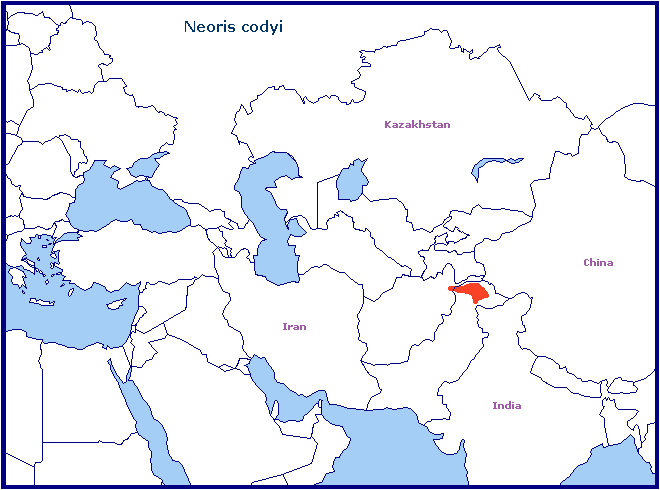UK: Cody's Emperor Moth.
Saturnia codyi Peigler, 1996, Journal of Research on the Lepidoptera 32: 8-9.Type locality: Pakistan, Northwest Frontier Province, Ghizar Mountains, Yasin.
(Taxonomic note. Some recent taxonomic works place this species in the genus Saturnia.)
Holarctic; western Palaearctic region. Pleistocene refuge: Monocentric -- Sindian refuge.
Wingspan 110--116mm. According to Peigler (1996), a very distinct species, with the submarginal area of all four wings pale-to-dark chocolate-brown in most individuals, giving the illusion that the postmedian line has a much stronger white component in both forewing and hindwing. The postmedian line is much smoother in the hindwing than in other species. In the forewing, the postmedian line is not drawn inwards as far at the anal margin than in other species. The antemedian line is weakly defined, even more so than in Neoris huttoni Moore, 1862. A band of similar colour runs across the eye-spots on both the upper- and undersides of each wing. The eye-spots themselves are smaller than in other species of Neoris, the wings proportionately more rounded and broader, and the median notch of the male valve is reduced. However, some individuals are similar to darker forms of Neoris huttoni in both colour and patterning.
![Paratype male of Neoris codyi, 'Bulachi', Kashmir, Pakistan [Bulochi, Astor/Astore valley, Astore District, Gilgit-Baltistan, Pakistan]. Photo: © Ric Peigler Paratype male of Neoris codyi, 'Bulachi', Kashmir, Pakistan [Bulochi, Astor/Astore valley, Astore District, Gilgit-Baltistan, Pakistan]. Photo: © Ric Peigler](n_cod_a1.gif)
Found around 4000m altitude.
Mid August to early September as one generation.
Unknown.
Unknown.
The Hindu Kush mountains of Gilgit-Baltistan, and western Azad Kashmir, Pakistan, and from here westwards into northeastern Afghanistan and eastwards into Jammu & Kashmir, India (Naumann, Löffler & Nässig, 2017).
Extra-limital range. None.

None.
 Return to species list
Return to species list